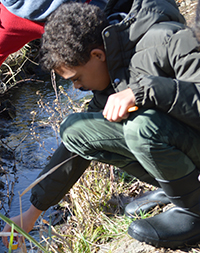Eighth-grader Colin Byers dipped a thermometer into the stream behind the Kentwood Ice Arena and looked at the results: 34.4 degrees Fahrenheit, a drop from previous months. He entered the data into his notebook and would later transfer it to Google Docs.
On the crisp November day, students worked together gathering calculations including the stream’s rate of flow, depth and width, and other variables. Each month, they head outside and take the short walk from Pinewood Middle School to the stream, a drainage area located off the M-6 highway. They see what has changed in the narrow, shallow waterway bordered by woods by comparing data since September, and will continue through the end of the school year.

Back in the lab, they use their data and water samples to determine pollutants in the stream by measuring pH, ammonia, nitrite and phosphorus levels.
“I like that we get to go outside and do everything hands-on,” said Colin. “It makes me want to do (science) more because we get to experience it ourselves. It’s not in the classroom all the time.”
Doing science more –and at a deeper level– is the plan for students who can potentially go far in high school science, even earning college credits. Through a partnership with East Kentwood High School AP Biology teacher Chad VanHouten, Pinewood Middle teachers Scott McDaid and Emily Rietberg are looking to build skills students need at the high-school level with the goal of growing the already strong number of students taking AP science courses in high school.
“Just getting kids outside, they’re excited,” Rietberg said. “Getting them excited about science and realizing they can do it is a big hurdle… You’re doing science by collection data and getting outside.”
If students are interested and confident about science, they are more likely to go further with it, said McDaid, and it’s got eighth-grader Jalen May thinking. “Knowing we might do this stuff definitely makes me consider it,” Jalen said.

Paving the Way for Young Scientists
McDaid and Rietberg modeled the project after VanHouten’s work with his biology students, but tweaked it for eighth-grade earth science. The inquiry-based instruction includes gathering long-term data to monitor changes over time, with no definite outcome expected. “Doing science” often results in more questions than answers, students learn.
Pinewood students have also visited VanHouten’s classroom, which doubles as a habitat for reptiles, birds and fish. And by working with VanHouten, McDaid and Rietburg are also focusing on incorporating SAT vocabulary into lessons, labs and assessments, the teachers said. The goal is to help students improve assessment and PSAT and SAT scores, McDaid said. The collaboration also allows middle schoolers to observe high school students in action.
The work also ties with Next Generation Science Standards, a set of teaching guidelines for kindergarten through 12th-graders, outlined in “A Framework for K-12 Science Education.” The standards emphasize inquiry-based science, like the field study.
For eighth-grader Susma Baral, studying the stream and working with classmates has given her a better idea of how things change in the environment. “Every time I come out here it’s different,” she said. “Science is basically in everything.”
CONNECT
SNN Article on Next Generation Science Standards










